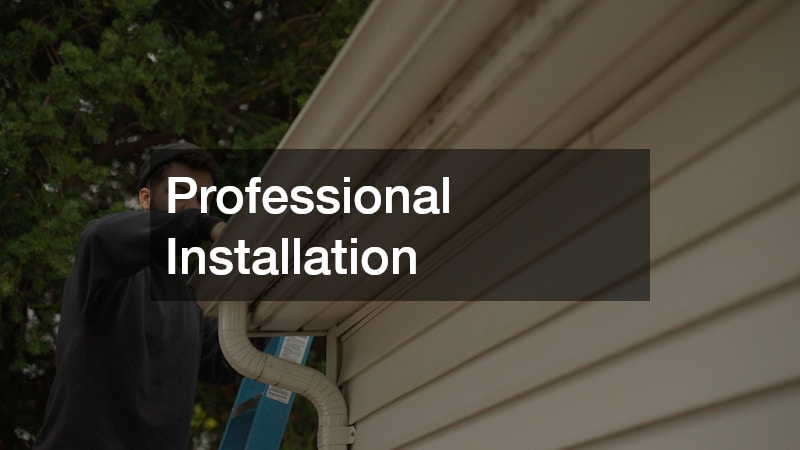Gutter guard installation is a crucial aspect of home maintenance that provides numerous benefits, including reduced maintenance effort, prevention of debris build-up, and extended lifespan of your gutters. Proper preparation can significantly enhance the effectiveness and longevity of gutter guards, ensuring that your home remains protected from potential water damage. This article aims to provide comprehensive guidance on preparing your home for gutter guard installation, ensuring you get the most out of this home improvement project.
Tools Needed for Gutter Guard Installation
Basic Tools Required
To get started with gutter guard installation, a few basic tools are indispensable. A sturdy ladder is essential to safely access your gutters without risking injury.
Additionally, you’ll need a pair of durable gloves to protect your hands while working and a reliable screwdriver to attach the guards securely.
Having a bucket or container on hand can help manage debris as you work, keeping your workspace organized and efficient. A measuring tape is also crucial for ensuring that your gutter guards fit correctly, preventing future issues with ineffective installation. For convenience, a cordless drill can replace a manual screwdriver, making the task quicker and less labor-intensive.
By assembling these basic tools, you ensure a smoother installation process, avoiding unnecessary delays. This preparation step helps to streamline your work and promotes effectiveness. It’s important to inspect all tools before use to confirm they are in working condition, reducing any safety risks during the project.
Specialized Equipment
Depending on the type of gutter guard you choose, specialized tools might be necessary to overcome architectural challenges specific to your home. For instance, if your gutters are unusually angled, a gutter guard with a flex-fit design may require adjustable wrenches or pliers for precision installation. Additionally, cutting tools, such as tin snips or a power saw, may be necessary for customizing guard lengths to fit your specific gutter dimensions.
For homes located in areas with frequent rain or large rooftop surfaces, water flow tests can ensure that the guards function efficiently at redirecting rainwater. In such scenarios, a hose or water simulator can be used to test drainage capabilities and identify any potential areas for improvement. If your home has ornate or steep roofing, special harnesses or additional protective gear may be required to ensure your safety while installing gutter guards.
Understanding the unique requirements of your home’s architecture ensures that the installation is both safe and effective. Specialized equipment doesn’t just facilitate a smoother installation process; it also contributes to a more tailored fit for your gutter guards. As a result, taking the time to assess and procure specialized equipment can greatly enhance the installation’s success and reliability.
How to Clean Gutters Before Installing Gutter Guards
Effective Cleaning Techniques
Thorough cleaning of gutters before installing guards is essential to prevent blockages and ensure optimal performance. Start by removing large debris by hand or with a trowel, which can effectively scoop out leaves and twigs. Once the larger debris is cleared, use a garden hose to flush out remaining dirt and smaller particles, guiding the water toward downspouts to ensure they are unclogged.
A high-pressure hose attachment can further enhance water flow, removing stubborn grime adhered to the gutter’s edges. Soft-bristle brushes may be useful for scrubbing away any tenacious dirt without scratching metal surfaces. During this cleaning process, keep an eye out for signs of rust or damage in your gutters, as these need to be addressed before installation.
Safety Precautions During Cleaning
Ensuring safety during gutter cleaning is paramount. Always stabilize your ladder on firm, level ground to prevent it from tipping over while you work, and never lean too far from the ladder’s center of gravity. For added stability, consider using a ladder brace or securing the ladder to a sturdy part of your home’s structure.
Wear non-slip shoes to maintain good footing, especially if you plan on moving along the roof’s edge. Protective eyewear and long-sleeved clothing can shield you from falling debris and sudden gusts of wind. Additionally, having a spotter or helper to stabilize the ladder can further enhance safety, allowing you to focus on the task at hand.
Professional Installation
Hiring professional gutter guard installers has its own unique advantages. Professionals bring expertise and experience, ensuring that the installation is done efficiently and correctly the first time. Their knowledge of various guard types and installation techniques can be invaluable in tailoring the solution to fit your home’s specific needs.
Additionally, professional services often come with warranties or guarantees, providing peace of mind regarding the quality of the work performed. This reassurance can be particularly beneficial if your home has complex architectural designs or challenging installation conditions. It also minimizes the risk of long-term issues such as leaks or misalignments, which can be costly to rectify if not addressed immediately.
Preparing your home for gutter guard installation is a critical step in enhancing your home’s maintenance strategy. Whether opting for DIY installation or hiring professionals, careful preparation and understanding of the processes involved are essential for success. Properly installed gutter guards can save you time, effort, and costs in home maintenance, shielding your home from future water damage and enhancing its overall longevity.

